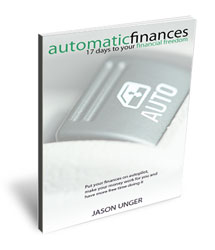
Since today’s post is about automation again, I can use another picture of a robot. So here’s a robot with a frog.
Automating your long-term savings is the key to protecting yourself … from yourself. When you’re attacking a long-term goal, it’s incredibly easy to procrastinate or convince yourself that something else is more important.
When it comes to retirement investing, automation also has a number of other benefits, which you’ll learn about today.
Enjoy.
******************************
Now that your retirement accounts are up and running, it’s time to start the investment process – and keep it going.
While any retirement plan you have with your employer will automatically receive contributions directly from your paycheck, you’ll need to set up automatic transfers to your other accounts, like your new Roth IRA.
Follow the instructions on your financial institution’s Web site to begin your investments and set up automatic contributions, using the amount you have left in your flux account. If you’d like to be investing more – which is great! – make changes to your budget to allow for a higher retirement contribution.
(While we won’t suggest an exact investing plan for you, you may be able to get by with as little as two funds. Read Paul B. Farrell’s “The Lazy Person’s Guide to Investing: A Book for Procrastinators, the Financially Challenged, and Everyone Who Worries About Dealing With Their Money” to find out more.)
How You Benefit From Automating Your Retirement Contributions
When you set your retirement contributions to automatically occur every month, there are a number of benefits, including:
- Dollar Cost Averaging – By spending the same amount of money on your investments every month, you buy less when the market is high and more when the market is low. This is called “dollar cost averaging” because, over time, the cost you spend per share averages out.
- No Temptation to Time the Market – If you’re constantly monitoring the markets for the right time to invest your monthly retirement amount, you’re playing a loser’s game. Let your automated contributions happen on a regular schedule and you won’t waste time trying to figure out when to invest.
- Fewer Fees – Some financial institutions will not charge certain fees when you are set up to automatically invest every month. Fees can eat up your savings overtime; whenever you can avoid them, it’s worth it.
Why You Should Set It and Forget It
When you’re investing for retirement, you’re in it for the long term. Despite the up and downs of the stock market on any given day, week or month, you will not be using that money for years.
After you determine what you’ll be investing in, and set it to happen on a regular occasion – once every other week, once a month, etc. – don’t touch it.
Don’t take a loan out against it. Don’t pull it all out when the market drops. And don’t throw money at it when it’s going up. You’ve got a schedule set with automatic contributions – the last thing you need is to add human error into the mix.
Depending on your level of confidence, you may not want to check your retirement portfolio more than once a quarter or even once a year. Remember, it will go up and it will go down – but you’re not using it anytime soon.
Use your judgment to decide how often you can stomach seeing the swings in your account.
TIP: While it can be easy to procrastinate contributing to your retirement, the longer you wait, the less money you’ll have. Albert Einstein reportedly called compound interest – the money you make from the interest you earn – “the most powerful force in the universe.” The earlier you start investing, the more time you have for compound interest to build your retirements.



